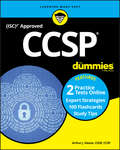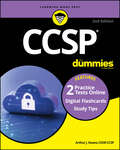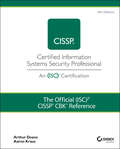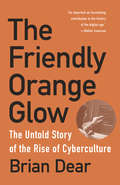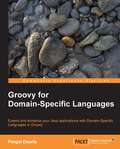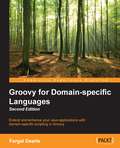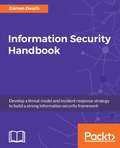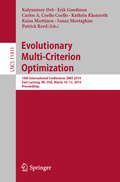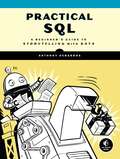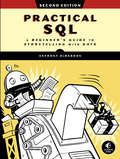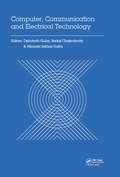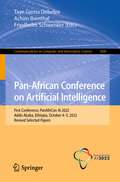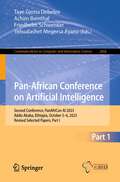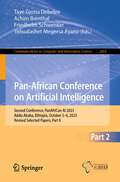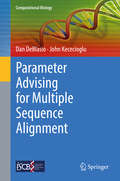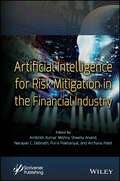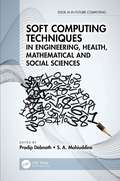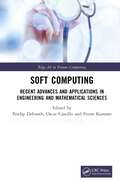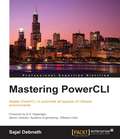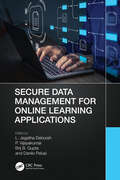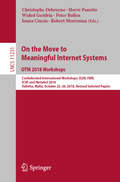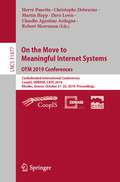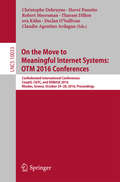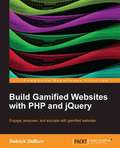- Table View
- List View
CCSP For Dummies with Online Practice
by DeaneSecure your CSSP certification CCSP is the world’s leading Cloud Security certification. It covers the advanced technical skills and knowledge to design, manage, and secure data, applications, and infrastructure in the cloud using best practices, policies, and procedures. If you’re a cloud security professional seeking your CSSP certification, this book is a perfect way to prepare for the exam. Covering in detail all six domains, the expert advice in this book gives you key information you'll need to pass the exam. In addition to the information covered on the exam, you'll get tips on setting up a study plan, tips for exam day, and access to an online test bank of questions. Key information for all six exam domains Test -taking and exam day tips and tricks Free online practice questions and flashcards Coverage of the core concepts From getting familiar with the core concepts to establishing a study plan, this book is all you need to hang your hat on that certification!
CCSP For Dummies: Book + 2 Practice Tests + 100 Flashcards Online
by Arthur J. DeaneGet CCSP certified and elevate your career into the world of cloud security CCSP For Dummies is a valuable resource for anyone seeking to gain their Certified Cloud Security Professional (CCSP) certification and advance their cloud security career. This book offers a thorough review of subject knowledge in all six domains, with real-world examples and scenarios, so you can be sure that you’re heading into test day with the most current understanding of cloud security. You’ll also get tips on setting up a study plan and getting ready for exam day, along with digital flashcards and access to two updated online practice tests. . Review all content covered on the CCSP exam with clear explanations Prepare for test day with expert test-taking strategies, practice tests, and digital flashcards Get the certification you need to launch a lucrative career in cloud security Set up a study plan so you can comfortably work your way through all subject matter before test dayThis Dummies study guide is excellent for anyone taking the CCSP exam for the first time, as well as those who need to brush up on their skills to renew their credentials.
The Official (ISC)2 CISSP CBK Reference
by Arthur J. Deane Aaron KrausThe only official, comprehensive reference guide to the CISSP Thoroughly updated for 2021 and beyond, this is the authoritative common body of knowledge (CBK) from (ISC)2 for information security professionals charged with designing, engineering, implementing, and managing the overall information security program to protect organizations from increasingly sophisticated attacks. Vendor neutral and backed by (ISC)2, the CISSP credential meets the stringent requirements of ISO/IEC Standard 17024. This CBK covers the current eight domains of CISSP with the necessary depth to apply them to the daily practice of information security. Revised and updated by a team of subject matter experts, this comprehensive reference covers all of the more than 300 CISSP objectives and sub-objectives in a structured format with: Common and good practices for each objective Common vocabulary and definitions References to widely accepted computing standards Highlights of successful approaches through case studies Whether you've earned your CISSP credential or are looking for a valuable resource to help advance your security career, this comprehensive guide offers everything you need to apply the knowledge of the most recognized body of influence in information security.
The Friendly Orange Glow: The Untold Story of the PLATO System and the Dawn of Cyberculture
by Brian DearAt a time when Steve Jobs was only a teenager and Mark Zuckerberg wasn’t even born, a group of visionary engineers and designers—some of them only high school students—in the late 1960s and 1970s created a computer system called PLATO, which was light-years ahead in experimenting with how people would learn, engage, communicate, and play through connected computers. Not only did PLATO engineers make significant hardware breakthroughs with plasma displays and touch screens but PLATO programmers also came up with a long list of software innovations: chat rooms, instant messaging, message boards, screen savers, multiplayer games, online newspapers, interactive fiction, and emoticons. Together, the PLATO community pioneered what we now collectively engage in as cyberculture. They were among the first to identify and also realize the potential and scope of the social interconnectivity of computers, well before the creation of the internet. PLATO was the foundational model for every online community that was to follow in its footsteps. The Friendly Orange Glow is the first history to recount in fascinating detail the remarkable accomplishments and inspiring personal stories of the PLATO community. The addictive nature of PLATO both ruined many a college career and launched pathbreaking multimillion-dollar software products. Its development, impact, and eventual disappearance provides an instructive case study of technological innovation and disruption, project management, and missed opportunities. Above all, The Friendly Orange Glow at last reveals new perspectives on the origins of social computing and our internet-infatuated world.
Groovy for Domain-Specific Languages
by Fergal DearleThis book is a practical tutorial, walking the reader through examples of building DSLs with Groovy covering meta-programming with Groovy. Some complex concepts are covered in the book but we go through these in a clear and methodically way so that readers will gain a good working knowledge of the techniques involved. This book is for Java software developers who have an interest in building domain scripting into their Java applications. No knowledge of Groovy is required, although it will be helpful. The book does not teach Groovy, but quickly introduces the basic ideas of Groovy. An experienced Java developer should have no problems with these and move quickly on to the more involved aspects of creating DSLs with Groovy. No experience of creating a DSL is required. The book should also be useful for experienced Groovy developers who have so far only used Groovy DSLs such as Groovy builders and would like to start building their own Groovy-based DSLs.
Groovy for Domain-specific Languages - Second Edition
by Fergal DearleExtend and enhance your Java applications with domain-specific scripting in Groovy About This Book * Build domain-specific mini languages in Groovy that integrate seamlessly with your Java apps with this hands-on guide * Increase stakeholder participation in the development process with domain-specific scripting in Groovy * Get up to speed with the newest features in Groovy using this second edition and integrate Groovy-based DSLs into your existing Java applications. Who This Book Is For This book is for Java software developers who have an interest in building domain scripting into their Java applications. No knowledge of Groovy is required, although it will be helpful. This book does not teach Groovy, but quickly introduces the basic ideas of Groovy. An experienced Java developer should have no problems with these and move quickly on to the more involved aspects of creating DSLs with Groovy. No experience of creating a DSL is required. What You Will Learn * Familiarize yourself with Groovy scripting and work with Groovy closures * Use the meta-programming features in Groovy to build mini languages * Employ Groovy mark-up and builders to simplify application development * Familiarize yourself with Groovy mark-up and build your own Groovy builders * Build effective DSLs with operator overloading, command chains, builders, and a host of other Groovy language features * Integrate Groovy with your Java and JVM based applications In Detail The times when developing on the JVM meant you were a Java programmer have long passed. The JVM is now firmly established as a polyglot development environment with many projects opting for alternative development languages to Java such as Groovy, Scala, Clojure, and JRuby. In this pantheon of development languages, Groovy stands out for its excellent DSL enabling features which allows it to be manipulated to produce mini languages that are tailored to a project's needs. A comprehensive tutorial on designing and developing mini Groovy based Domain Specific Languages, this book will guide you through the development of several mini DSLs that will help you gain all the skills needed to develop your own Groovy based DSLs with confidence and ease. Starting with the bare basics, this book will focus on how Groovy can be used to construct domain specific mini languages, and will go through the more complex meta-programming features of Groovy, including using the Abstract Syntax Tree (AST). Practical examples are used throughout this book to de-mystify these seemingly complex language features and to show how they can be used to create simple and elegant DSLs. Packed with examples, including several fully worked DSLs, this book will serve as a springboard for developing your own DSLs. Style and approach This book is a hands-on guide that will walk you through examples for building DSLs with Groovy rather than just talking about "metaprogramming with Groovy". The examples in this book have been designed to help you gain a good working knowledge of the techniques involved and apply these to producing your own Groovy based DSLs.
Information Security Handbook
by Darren DeathImplement information security effectively as per your organization's needs. About This Book • Learn to build your own information security framework, the best fit for your organization • Build on the concepts of threat modeling, incidence response, and security analysis • Practical use cases and best practices for information security Who This Book Is For This book is for security analysts and professionals who deal with security mechanisms in an organization. If you are looking for an end to end guide on information security and risk analysis with no prior knowledge of this domain, then this book is for you. What You Will Learn • Develop your own information security framework • Build your incident response mechanism • Discover cloud security considerations • Get to know the system development life cycle • Get your security operation center up and running • Know the various security testing types • Balance security as per your business needs • Implement information security best practices In Detail Having an information security mechanism is one of the most crucial factors for any organization. Important assets of organization demand a proper risk management and threat model for security, and so information security concepts are gaining a lot of traction. This book starts with the concept of information security and shows you why it's important. It then moves on to modules such as threat modeling, risk management, and mitigation. It also covers the concepts of incident response systems, information rights management, and more. Moving on, it guides you to build your own information security framework as the best fit for your organization. Toward the end, you'll discover some best practices that can be implemented to make your security framework strong. By the end of this book, you will be well-versed with all the factors involved in information security, which will help you build a security framework that is a perfect fit your organization's requirements. Style and approach This book takes a practical approach, walking you through information security fundamentals, along with information security best practices.
Evolutionary Multi-Criterion Optimization: 10th International Conference, EMO 2019, East Lansing, MI, USA, March 10-13, 2019, Proceedings (Lecture Notes in Computer Science #11411)
by Kalyanmoy Deb Erik Goodman Carlos A. Coello Coello Kathrin Klamroth Kaisa Miettinen Sanaz Mostaghim Patrick ReedThis book constitutes the refereed proceedings of the 10th International Conference on Evolutionary Multi-Criterion Optimization, EMO 2019 held in East Lansing, MI, USA, in March 2019.The 59 revised full papers were carefully reviewed and selected from 76 submissions. The papers are divided into 8 categories, each representing a key area of current interest in the EMO field today. They include theoretical developments, algorithmic developments, issues in many-objective optimization, performance metrics, knowledge extraction and surrogate-based EMO, multi-objective combinatorial problem solving, MCDM and interactive EMO methods, and applications.
Practical SQL: A Beginner's Guide to Storytelling with Data
by Anthony DeBarrosPractical SQL is an approachable and fast-paced guide to SQL (Structured Query Language), the standard programming language for defining, organizing, and exploring data in relational databases. The book focuses on using SQL to find the story your data tells, with the popular open-source database PostgreSQL and the pgAdmin interface as its primary tools. You’ll first cover the fundamentals of databases and the SQL language, then build skills by analyzing data from the U.S. Census and other federal and state government agencies. With exercises and real-world examples in each chapter, this book will teach even those who have never programmed before all the tools necessary to build powerful databases and access information quickly and efficiently. You’ll learn how to: -Create databases and related tables using your own data -Define the right data types for your information -Aggregate, sort, and filter data to find patterns -Use basic math and advanced statistical functions -Identify errors in data and clean them up -Import and export data using delimited text files -Write queries for geographic information systems (GIS) -Create advanced queries and automate tasks Learning SQL doesn’t have to be dry and complicated. Practical SQL delivers clear examples with an easy-to-follow approach to teach you the tools you need to build and manage your own databases. This book uses PostgreSQL, but the SQL syntax is applicable to many database applications, including Microsoft SQL Server and MySQL.
Practical SQL, 2nd Edition: A Beginner's Guide to Storytelling with Data
by Anthony DeBarrosAnalyze data like a pro, even if you&’re a beginner.Practical SQL is an approachable and fast-paced guide to SQL (Structured Query Language), the standard programming language for defining, organizing, and exploring data in relational databases. Anthony DeBarros, a journalist and data analyst, focuses on using SQL to find the story within your data. The examples and code use the open-source database PostgreSQL and its companion pgAdmin interface, and the concepts you learn will apply to most database management systems, including MySQL, Oracle, SQLite, and others.*You&’ll first cover the fundamentals of databases and the SQL language, then build skills by analyzing data from real-world datasets such as US Census demographics, New York City taxi rides, and earthquakes from US Geological Survey. Each chapter includes exercises and examples that teach even those who have never programmed before all the tools necessary to build powerful databases and access information quickly and efficiently.You&’ll learn how to: • Create databases and related tables using your own data • Aggregate, sort, and filter data to find patterns • Use functions for basic math and advanced statistical operations • Identify errors in data and clean them up • Analyze spatial data with a geographic information system (PostGIS) • Create advanced queries and automate tasksThis updated second edition has been thoroughly revised to reflect the latest in SQL features, including additional advanced query techniques for wrangling data. This edition also has two new chapters: an expanded set of instructions on for setting up your system plus a chapter on using PostgreSQL with the popular JSON data interchange format. Learning SQL doesn&’t have to be dry and complicated. Practical SQL delivers clear examples with an easy-to-follow approach to teach you the tools you need to build and manage your own databases.* Microsoft SQL Server employs a variant of the language called T-SQL, which is not covered by Practical SQL.
Computer, Communication and Electrical Technology: Proceedings of the International Conference on Advancement of Computer Communication and Electrical Technology (ACCET 2016), West Bengal, India, 21-22 October 2016
by Debatosh Guha; Badal Chakraborty; Himadri Sekhar DuttaThe First International Conference on Advancement of Computer, Communication and Electrical Technology focuses on key technologies and recent progress in computer vision, information technology applications, VLSI, signal processing, power electronics & drives, and application of sensors & transducers, etc. Topics in this conference include: Computer ScienceThis conference encompassed relevant topics in computer science such as computer vision & intelligent system, networking theory, and application of information technology. Communication EngineeringTo enhance the theory & technology of communication engineering, ACCET 2016 highlighted the state-of the-art research work in the field of VLSI, optical communication, and signal processing of various data formatting. Research work in the field of microwave engineering, cognitive radio and networks are also included. Electrical TechnologyThe state-of-the-art research topic in the field of electrical & instrumentation engineering is included in this conference such as power system stability & protection, non-conventional energy resources, electrical drives, and biomedical engineering. Research work in the area of optimization and application in control, measurement & instrumentation are included as well.
Pan-African Conference on Artificial Intelligence: First Conference, PanAfriCon AI 2022, Addis Ababa, Ethiopia, October 4–5, 2022, Revised Selected Papers (Communications in Computer and Information Science #1800)
by Taye Girma Debelee Achim Ibenthal Friedhelm SchwenkerThis volume consitutes selected papers presented during the First Pan-African Conference on Artificial Intelligence, PanAfriCon AI 2022, held in Addis Ababa, Ethiopia, in October 2022. The 16 papers were thoroughly reviewed and selected from the 49 qualified submissions. The papers are organized in the following topical sections: AI in public health; agriculture; algorithmic optimization; human-machine interaction; economy and security.
Pan-African Conference on Artificial Intelligence: Second Conference, PanAfriCon AI 2023, Addis Ababa, Ethiopia, October 5–6, 2023, Revised Selected Papers, Part I (Communications in Computer and Information Science #2068)
by Taye Girma Debelee Achim Ibenthal Friedhelm Schwenker Yehualashet Megersa AyanoThis two-volume set, CCIS 2068 and 2069, constitutes selected papers presented during the Second Pan-African Conference on Artificial Intelligence, PanAfriCon AI 2023, held in Addis Ababa, Ethiopia, in October 2023. The set goal of the conference is to exchange the best practices of joint Pan-African efforts to provide solutions for Africa’s key 21st century challenges in the social, economic and ecologic domains. The 29 papers were thoroughly reviewed and selected from 134 submissions. The papers are organized in the following topical sections: Medical AI; Natural Language Processing, Text and Speech Processing; AI in Finance and Cyber Security; Autonomous Vehicles; AI Ethics and Life Sciences.
Pan-African Conference on Artificial Intelligence: Second Conference, PanAfriCon AI 2023, Addis Ababa, Ethiopia, October 5–6, 2023, Revised Selected Papers, Part II (Communications in Computer and Information Science #2069)
by Taye Girma Debelee Achim Ibenthal Friedhelm Schwenker Yehualashet Megersa AyanoThis two-volume set, CCIS 2068 and 2069, constitutes selected papers presented during the Second Pan-African Conference on Artificial Intelligence, PanAfriCon AI 2023, held in Addis Ababa, Ethiopia, in October 2023. The set goal of the conference is to exchange the best practices of joint Pan-African efforts to provide solutions for Africa’s key 21st century challenges in the social, economic and ecologic domains. The 29 papers were thoroughly reviewed and selected from 134 submissions. The papers are organized in the following topical sections: Medical AI; Natural Language Processing, Text and Speech Processing; AI in Finance and Cyber Security; Autonomous Vehicles; AI Ethics and Life Sciences.
Parameter Advising for Multiple Sequence Alignment
by Dan DeBlasio John KececiogluThis book develops a new approach called parameter advising for finding a parameter setting for a sequence aligner that yields a quality alignment of a given set of input sequences. In this framework, a parameter advisor is a procedure that automatically chooses a parameter setting for the input, and has two main ingredients: (a) the set of parameter choices considered by the advisor, and (b) an estimator of alignment accuracy used to rank alignments produced by the aligner. On coupling a parameter advisor with an aligner, once the advisor is trained in a learning phase, the user simply inputs sequences to align, and receives an output alignment from the aligner, where the advisor has automatically selected the parameter setting. The chapters first lay out the foundations of parameter advising, and then cover applications and extensions of advising. The content * examines formulations of parameter advising and their computational complexity, * develops methods for learning good accuracy estimators, * presents approximation algorithms for finding good sets of parameter choices, and * assesses software implementations of advising that perform well on real biological data. Also explored are applications of parameter advising to * adaptive local realignment, where advising is performed on local regions of the sequences to automatically adapt to varying mutation rates, and * ensemble alignment, where advising is applied to an ensemble of aligners to effectively yield a new aligner of higher quality than the individual aligners in the ensemble. The book concludes by offering future directions in advising research.
Artificial Intelligence for Risk Mitigation in the Financial Industry
by Narayan C. Debnath Archana Patel Purvi Pokhariyal Shweta Anand Ambrish Kumar MishraArtificial Intelligence for Risk Mitigation in the Financial Industry This book extensively explores the implementation of AI in the risk mitigation process and provides information for auditing, banking, and financial sectors on how to reduce risk and enhance effective reliability. The applications of the financial industry incorporate vast volumes of structured and unstructured data to gain insight into the financial and non-financial performance of companies. As a result of exponentially increasing data, auditors and management professionals need to enhance processing capabilities while maintaining the effectiveness and reliability of the risk mitigation process. The risk mitigation and audit procedures are processes involving the progression of activities to “transform inputs into output.” As AI systems continue to grow mainstream, it is difficult to imagine an aspect of risk mitigation in the financial industry that will not require AI-related assurance or AI-assisted advisory services. AI can be used as a strong tool in many ways, like the prevention of fraud, money laundering, and cybercrime, detection of risks and probability of NPAs at early stages, sound lending, etc. Audience This is an introductory book that provides insights into the advantages of risk mitigation by the adoption of AI in the financial industry. The subject is not only restricted to individuals like researchers, auditors, and management professionals, but also includes decision-making authorities like the government. This book is a valuable guide to the utilization of AI for risk mitigation and will serve as an important standalone reference for years to come.
Soft Computing Techniques in Engineering, Health, Mathematical and Social Sciences (Edge AI in Future Computing)
by Pradip Debnath S. A. MohiuddineSoft computing techniques are no longer limited to the arena of computer science. The discipline has an exponentially growing demand in other branches of science and engineering and even into health and social science. This book contains theory and applications of soft computing in engineering, health, and social and applied sciences. Different soft computing techniques such as artificial neural networks, fuzzy systems, evolutionary algorithms and hybrid systems are discussed. It also contains important chapters in machine learning and clustering. This book presents a survey of the existing knowledge and also the current state of art development through original new contributions from the researchers. This book may be used as a one-stop reference book for a broad range of readers worldwide interested in soft computing. In each chapter, the preliminaries have been presented first and then the advanced discussion takes place. Learners and researchers from a wide variety of backgrounds will find several useful tools and techniques to develop their soft computing skills. This book is meant for graduate students, faculty and researchers willing to expand their knowledge in any branch of soft computing. The readers of this book will require minimum prerequisites of undergraduate studies in computation and mathematics.
Soft Computing: Recent Advances and Applications in Engineering and Mathematical Sciences (Edge AI in Future Computing)
by Pradip Debnath Sushil Kumar Solanki Oscar Castillo Poom KumamThis book explores soft computing techniques in a systematic manner starting from their initial stage to recent developments in this area. The book presents a survey of the existing knowledge and the current state-of-the-art development through cutting-edge original new contributions from the researchers. Soft Computing: Recent Advances and Applications in Engineering and Mathematical Sciences presents a survey of the existing knowledge and the current state-of-the-art development through cutting-edge original new contributions from the researchers. As suggested by the title, this book particularly focuses on the recent advances and applications of soft computing techniques in engineering and mathematical sciences. Chapter 1 describes the contribution of soft computing techniques towards a new paradigm shift. The subsequent chapters present a systematic application of fuzzy logic in mathematical sciences and decision-making. New research directions are also provided at the end of each chapter. The application of soft computing in health sciences and in the modeling of epidemics including the effects of vaccination are also examined. Sustainability of green product development, optimum design of 3D steel frame, digitalization investment analysis in the maritime industry, forecasting return rates of individual pension funds are among some of the topics where engineering and industrial applications of soft computing have been studied in the book. The readers of this book will require minimum prerequisites of undergraduate studies in computation and mathematics. This book is meant for graduate students, faculty, and researchers who are applying soft computing in engineering and mathematics. New research directions are also provided at the end of each chapter.
Mastering PowerCLI
by Sajal DebnathMaster PowerCLI to automate all aspects of VMware environments About This Book * Leverage PowerCLI to perform administration tasks in a more effective and efficient way * Escape from daily tedious and repetitive tasks by unleashing the full potential of your creative side through scripting * Master the intricate workings of PowerShell and PowerCLI through easy and real-life examples Who This Book Is For If you are a system administrator with working knowledge of PowerShell and PowerCLI who wants to perform quick and easy scripting but at the same time achieve complex results and write production grade scripts, then this book is for you. What You Will Learn * Use GitHub for collaboration and Pester to automate unit tests * Write advanced reusable functions and dynamic variables and learn about error handling in PowerShell * Automate ESXi host installation using Auto-Deploy, host profile, and host image * Implement security best practices in a vSphere data center * Manage SRM, vCloud Air, and vRealize Operations environments * Access and utilize vSphere APIs to manage advanced aspects of vSphere and work with .NET view objects * Utilize REST APIs to manage vRealize Automation environments * Create a Windows GUI through the use of PowerShell and Sapien PrimalForms CE In Detail Have you ever wished that every morning you could automatically get a report with all the relevant information about your datacenter in exactly the same format you want? Or whether you could automate that boring, exhausting task? What if some crucial task needs to be performed on a regular basis without any error? PowerCLI scripts do all that and much more for VMware environments. It is built on top of the popular Windows PowerShell, with which you can automate server tasks and reduce manual input, allowing you to focus on more important tasks. This book will help you to achieve your goals by starting with a short refresher on PowerShell and PowerCLI and then covering the nuances of advanced functions and reusable scripts. Next you will learn how to build a vSphere-powered virtualized datacenter using PowerCLI while managing different aspects of the environment including automated installation, network, and storage. You will then manage different logical constructs of vSphere environment and different aspects of a virtual machine. Later, you will implement the best practices for a security implementation in vSphere Environment through PowerCLI before discovering how to manage other VMware environments such as SRM, vCloud Director and vCloud Air through PowerCLI. You will also learn to manage vSphere environments using advanced properties by accessing vSphere API and REST APIs through PowerCLI. Finally, you will build a Windows GUI application using PowerShell followed by a couple of sample scripts for reporting and managing vSphere environments with detailed explanations of the scripts. By the end of the book, you will have the required in-depth knowledge to master the art of PowerCLI scripting. Style and approach In this book, every topic is explained in a very easy-to-follow fashion with real-life, simple examples so that you get an idea of not only the topic but also the context in which it should be used or where it can be best utilized.
Introduction To Linear Algebra: Computation, Application, and Theory (Textbooks in Mathematics)
by Mark J. DeBonisIntroduction to Linear Algebra: Computation, Application, and Theory is designed for students who have never been exposed to the topics in a linear algebra course. The text is filled with interesting and diverse application sections but is also a theoretical text which aims to train students to do succinct computation in a knowledgeable way. After completing the course with this text, the student will not only know the best and shortest way to do linear algebraic computations but will also know why such computations are both effective and successful. Features: Includes cutting edge applications in machine learning and data analytics Suitable as a primary text for undergraduates studying linear algebra Requires very little in the way of pre-requisites
Secure Data Management for Online Learning Applications
by L. Jegatha Deborah P. Vijayakumar Brij B. Gupta Danilo PelusiWith the increasing use of e-learning, technology has not only revolutionized the way businesses operate but has also impacted learning processes in the education sector. E-learning is slowly replacing traditional methods of teaching and security in e-learning is an important issue in this educational context. With this book, you will be familiarized with the theoretical frameworks, technical methodologies, information security, and empirical research findings in the field to protect your computers and information from threats. Secure Data Management for Online Learning Applications will keep you interested and involved throughout.
On the Move to Meaningful Internet Systems: Confederated International Workshops: EI2N, FBM, ICSP, and Meta4eS 2018, Valletta, Malta, October 22–26, 2018, Revised Selected Papers (Lecture Notes in Computer Science #11231)
by Christophe Debruyne Hervé Panetto Wided Guédria Peter Bollen Ioana Ciuciu Robert MeersmanThis volume constitutes the refereed proceedings of the Confederated International International Workshop on Enterprise Integration, Interoperability and Networking (EI2N ), Fact Based Modeling ( FBM), Industry Case Studies Program ( ICSP ), and International Workshop on Methods, Evaluation, Tools and Applications for the Creation and Consumption of Structured Data for the e-Society (Meta4eS), held as part of OTM 2018 in October 2018 in Valletta, Malta.As the three main conferences and the associated workshops all share the distributed aspects of modern computing systems, they experience the application pull created by the Internet and by the so-called Semantic Web, in particular developments of Big Data, increased importance of security issues, and the globalization of mobile-based technologies.
On the Move to Meaningful Internet Systems: Confederated International Conferences: CoopIS, ODBASE, C&TC 2019, Rhodes, Greece, October 21–25, 2019, Proceedings (Lecture Notes in Computer Science #11877)
by Christophe Debruyne Hervé Panetto Robert Meersman Claudio Agostino Ardagna Dave Lewis Martin HeppThis volume LNCS 11877 constitutes the refereed proceedings of the Confederated International Conferences: Cooperative Information Systems, CoopIS 2019, Ontologies, Databases, and Applications of Semantics, ODBASE 2019, and Cloud and Trusted Computing, C&TC, held as part of OTM 2019 in October 2019 in Rhodes, Greece. The 38 full papers presented together with 8 short papers were carefully reviewed and selected from 156 submissions. The OTM program every year covers data and Web semantics, distributed objects, Web services, databases, informationsystems, enterprise workflow and collaboration, ubiquity, interoperability, mobility, grid and high-performance computing.
On the Move to Meaningful Internet Systems: OTM 2016 Conferences
by Christophe Debruyne Hervé Panetto Robert Meersman Tharam Dillon Eva Kühn Declan O'Sullivan Claudio Agostino ArdagnaThis volume constitutes the refereed proceedings of the Confederated International Conferences: Cooperative Information Systems, CoopIS 2016, Ontologies, Databases, and Applications of Semantics, ODBASE 2016, and Cloud and Trusted Computing, C&TC, held as part of OTM 2016 in October 2016 in Rhodes, Greece. The 45 full papers presented together with 16 short papers were carefully reviewed and selected from 133 submissions. The OTM program every year covers data and Web semantics, distributed objects, Web services, databases, information systems, enterprise work ow and collaboration, ubiquity, interoperability, mobility, grid and high-performance computing.
Build Gamified Websites with PHP and jQuery
by Detrick DeburrThis book is a standard tutorial, which walks you through the gamification development process, to help you incorporate game elements in an eLearning environment.This book is for jQuery and PHP developers who wish to gamify their educational websites.
